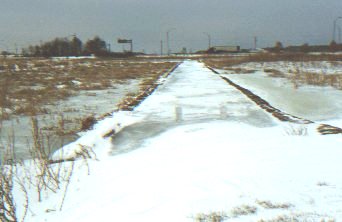CONSTRUCTED WETLANDS FOR STORM AND WASTE WATER TREATMENT
Byline : John W. Salm, III, P.E.
Part 2
 The
treatment system consists of three distinct beds; the Nitrification Bed, the
Denitrification Bed and the Reaeration Bed. These beds are mixed and matched in
different combinations and sizes to provide the exact, right amount of treatment
required for each application. This overlapping and reinforcing of treatment
steps provides for a vigorous system which is much more
reliable than single bed wetland systems.
The
treatment system consists of three distinct beds; the Nitrification Bed, the
Denitrification Bed and the Reaeration Bed. These beds are mixed and matched in
different combinations and sizes to provide the exact, right amount of treatment
required for each application. This overlapping and reinforcing of treatment
steps provides for a vigorous system which is much more
reliable than single bed wetland systems.
The Nitrification Bed accepts the flow processes it downslope
via shallow subsurface flow. The water flows through several types of mineral
and organic material, each with different characteristics. In addition, the
water moves through the intercalated root system of at least four types of
emergent aquatic plants. These roots help remove pollutants from the water by
providing aerobic mircrosites for biochemical reactions. The Nitification Bed is
very effective at removing pollutants, which may itself provide a full treatment
in the warmer months. However, in the cold season when the plants are dormant,
its treatment performance is more limited and, therefore, is usually followed by
other treatment steps, such as the Denitrification Bed and the Reaeration Bed.
The Denitrification Bed simulates a natural swamp wetland
environment. Abundant microbiological activity occurs in the slowly moving
water and in the organic surface layer. Water is pulled through this layer and
filtered prior to being discharged or redistributed to the Reaeration Bed. At
this point, most pollutants have been removed to acceptable levels.
Click Here for Part 3
| Back to Lectures page
 The
treatment system consists of three distinct beds; the Nitrification Bed, the
Denitrification Bed and the Reaeration Bed. These beds are mixed and matched in
different combinations and sizes to provide the exact, right amount of treatment
required for each application. This overlapping and reinforcing of treatment
steps provides for a vigorous system which is much more
reliable than single bed wetland systems.
The
treatment system consists of three distinct beds; the Nitrification Bed, the
Denitrification Bed and the Reaeration Bed. These beds are mixed and matched in
different combinations and sizes to provide the exact, right amount of treatment
required for each application. This overlapping and reinforcing of treatment
steps provides for a vigorous system which is much more
reliable than single bed wetland systems.